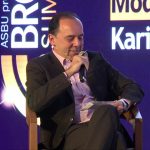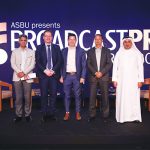While most of the Middle East focuses on the launch of new TV channels, Saudi Arabia now boasts a sophisticated network of radio complexes across the Kingdom. The most recent one to be unveiled is Jeddah Radio Complex, a 19-studio radio facility that is both state-of-the-art and completely digital. Vijaya Cherian brings you an exclusive […]
While most of the Middle East focuses on the launch of new TV channels, Saudi Arabia now boasts a sophisticated network of radio complexes across the Kingdom. The most recent one to be unveiled is Jeddah Radio Complex, a 19-studio radio facility that is both state-of-the-art and completely digital. Vijaya Cherian brings you an exclusive report

Saudi Ministry of Culture and Information (MOCI) recently took delivery of a state-of-the- art digital radio complex in Jeddah. The radio part of the multi-million dollar project was undertaken by Saudi MOCI in conjunction with local systems integrator Delta and German systems integrator BFE.
Saudi Radio was originally established in Jeddah about 70 years ago, recalls Dr. Riyadh Najm, deputy minister of information affairs, Saudi Ministry of Culture and Information.
The old Jeddah studios were built in 1966 and needed to be renovated in terms of the building as well as the studio equipment. In fact, more radio programmes are originating from Jeddah so it was time to rebuild the facility.
The Jeddah Radio Complex covers an area of 14,000sqm. The radio part of the facility includes 19 studios and 21 control rooms in addition to the central control rooms, a MENOS exchange system room, a satellite receiver, a central archive, a library as well as several other amenities. This building has also been designed to link directly with Saudi MOCIs radio facility in Riyadh.
Although all 19 studios are not operational yet, Dr. Najm says they will be fully operational in the future. Already, two 24-hour radio programmes including Nida AlIslam originate from Jeddah in addition to foreign radio programmes that are available in eight different languages. Irrespective of the origin of the content, all radio programmes are sent to Riyadh, from where it is dispatched to all the transmitting sites in the Kingdom and to the outside world.
Three permanent 24-hour programmes are run from Riyadh including general programming, the Quran and foreign local programming. Two of these are based in Jeddah along with foreign language programmes that are directed to listeners outside the Kingdom, explains Dr. Najm.
A unique aspect of this facility is the adoption of a box-in-box concept to ensure that all issues related to sound are addressed.

The use of the box-in-box concept isolates the studio from vibration and sounds in the surrounding environment, explains Dr. Najm.
The concept involves constructing double walls for the buildings. Double walls have been used when separating the studio from other halls or rooms to prevent sound and vibrations. In some cases, triple walls have been used to separate the control room from the middle wall. The use of elements such as rubber, screed and anti-static carpets within the studios have helped to further address audio issues.
With 19 studios that include seven recording studios, nine broadcasting studios, four editing suites and two mini-news booths, Jeddah Radio Complex is the largest radio facility presently available in the Kingdom or perhaps, even across the GCC.
This complex in Jeddah is the largest, endorses Dr. Najm. The Riyadh complex was overhauled and converted to a fully digital, tapeless facility three years ago, and it presently has 14 studios. In addition, we have built radio studios in Dammam, Madinah, Qasim, Abha and Jazan. We have also recently completed three radio and TV production centres in Tabuk, Hail and Jazan and each of these centres have two digital radio studios but Jeddah is the largest.
The new complex includes several unique features. For one, all of the broadcasting routes are secured with alternative routes should there be any interruption to the transmission or possible technical failures.
This is a fully digital radio system, thereby, helping to streamline the workflow and delivering operational features that will increase the professional quality, productivity and speed of performance, connectivity and content archival.
The key advantages of having a fully digital radio facility is the flexibility in the workflow, the speed with which you can move material around and being able to edit it by multiple users at the same time, explains Dr. Najm.
The elimination of tapes adds more flexibility and reduces both cost and pollution. In addition, the consumer enjoys a much higher sound quality.
The telephone systems deployed at this facility can take up to three calls at the same time on air, thereby, enabling the broadcaster to speak offline with a guest on the phone, even during the broadcast of a programme.
It supports VOIP and will eventually be integrated with the system at the Ministry and a central antenna system that provides the ground and satellite channels to the offices and technical rooms.
The studios are kitted out with all of the traditional broadcasting systems such as a CD and tape players along with a digital system that is designed to switch to a backup in the event of a potential interruption to the broadcast. In addition, the end user can control the timings of the programmes for news break inserts and prayer announcements.
In addition, a facility to allow the broadcast of breaking news without any reprogramming has been incorporated into the design. Text can be supplied inside the system to be electronically available to the presenter.
Saudi Press Agency is also fed into the same digital audio workstations. The studios are equipped with eight news stations and six aggregating stations.
Other elements of the facility include an IT network and radio broadcast infrastructure with sufficient backup servers to ensure zero interruption in transmission.
The complex includes a sophisticated archive library with a storage capacity of 36,000 hours as well as a central control room and an exchange system via satellite.
All of the electronic equipment in the studios is fully integrated into one digital network allowing simple and easy flow of the radio materials in file format around each part of the complex with use of any tapes or disks, explains Dr. Najm.
In addition, Jeddah Radio Complex is linked to Riyadh with multiple lines in both directions because all radio programmes are dispatched centrally from Riyadh to all the transmitting sites in the Kingdom and to the outside world, adds Dr. Najm.
We also need contribution circuits between Riyadh and Jeddah as they are the two main radio centres in the country, he explains.
In addition, the facility also makes use of the award-winning MENOS infrastructure, which was put in place by Saudi-based systems integrator First Gulf Company (FGC).
We use MENOS for two main purposes, which is primarily to send and receive radio programmes within the sites inside Saudi Arabia, and also to connect with all other Arab broadcasters, explains Dr. Najm.
The present staff at the Jeddah Radio Complex is being trained to operate this new facility.
This is not easy as staff are resistant to changes in the workflow. This is why we are operating the complex in stages. There are presently about 40 technical staff in Jeddah Radio and we may employ more in the future, adds Dr. Najm.
Jeddah Radio Complex was built according to the MOCIs specification which was made in compliance with the BBCs standards, according to Issam Al Abbasi, Department head for Telecom and Broadcast Projects, Delta Co. Ltd.
This project was awarded to Osais Establishment, which undertook the civil works including the box-in-box studios. Delta Company Ltd. was contracted to undertake all studio and electronic works in the project, which was, in turn, completed under the supervision of consultant D.T. Engineering, explains Al Abbasi.
Besides supplying kit for this project, Delta also delivered a Medium Wave Radio broadcasting station in K29 in Jeddah and completed 30 FM Radio broadcast stations in 30 cities, each transmitting five programmes via the Ministry of Culture and Information for the first private broadcasters in Saudi Arabia.
These projects use the MENOS satellite system, explains Al Abbasi.
Saudi MOCI and Delta worked with German systems integrator BFE on the radio project. BFE was responsible for the realisation of the entire broadcasting and information technology within the new broadcasting centre in Jeddah.
Within a period of 18 months, BFE put together 18 radio control rooms, 16 studios, 20 audio editing suites and two control rooms.
In addition to the planning, delivery, installation, integration and commissioning of the complete technical equipment, BFE was responsible for the equipment as well as the studio furniture, which was made in BFEs in-house workshops according to the design requirements of the Ministry of Culture and Information, explains Al Abbasi.
Clearly, a well networked tapeless radio facility was part of the mandate. However, further enhancements are likely to enable cross-linking with the radio station in Riyadh.
The central component of the entire project is an integrated transmission and archiving system from NETIA that is based on clients, servers and a storage solution from HP. Further components include two Nova73 MK2 Lawo routers and 34 Lawo Zircon and Z4 consoles in the main control rooms. The control of the broadcast infrastructure is handled by the BFE KSC Commander, a part of the KSC product line.
From the new radio station in Jeddah, Saudi Ministry of Culture and Information broadcasts six radio channels and with this, guarantees further dissemination of the radio programme offering in Saudi Arabia.

















































































